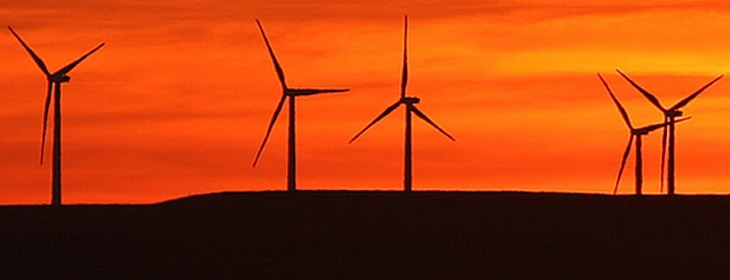Clean Line, DOE terminate controversial $2.5 billion wind project across Arkansas
by March 23, 2018 5:21 pm 2,388 views

Clean Line Energy and the Department of Energy (DOE) agreed Friday (March 23) to terminate the controversial $2.5 billion high-voltage wind power project across Arkansas, almost exactly three years after the Obama administration used a little known section of the 2005 Energy Policy Act to greenlight the proposed 720-mile development.
In a nine-page agreement signed by DOE Secretary Rick Perry and Clean Line executives, both parties quietly pulled out of the pact. The development marked the first use of Congressional authority handed to the DOE under Section 1222 of the Energy Policy Act of 2005 allowing the federal government to join with well-financed private partners to upgrade the nation’s energy grid.
“(The) Parties now desire to terminate each Party’s rights and obligations with respect to the Participation Agreement, and to mutually release each other Party as set forth below, in each case, excluding any rights and obligations that expressly survive such termination pursuant to the terms of the participation agreement and subject to the terms and conditions set forth herein,” the contract read.
Houston-based Clean Line Energy Partners made clear that the partnership and the DOE had “mutually agreed” to end the project.
According to federal court documents, the price tag for the three-state transmission line had jumped by several hundreds of millions of dollars over the past year as Clean Line sought to speed up a landowners’ lawsuit in Little Rock.
“The nature of the project has changed substantially since the DOE and Clean Line entered into an agreement,” Clean Line officials said in a statement. “In December 2017, NextEra Energy Resources acquired Plains and Eastern Clean Line Oklahoma LLC and all of the assets for the transmission project in Oklahoma.”
DOE officials have not responded to repeated inquiries from Talk Business & Politics concerning the Clean Line project. Talk Business & Politics reported in early January that the project was likely stalled.
The project first began to unravel Dec. 22 after the Texas partnership’s pre-Christmas announcement concerning the surprise sale of the Oklahoma leg of the multistate project to Juno, Beach, Fla.-based NextEra. The project further fell apart a few days into the New Year after the Tennessee Valley Authority (TVA) decided to drop its six-year-old interconnection agreement with the Texas partnership. That interconnection deal would have allowed Clean Line to ship wind power across Arkansas to a substation that terminates in Memphis, one of TVA’s largest power markets.
Also, the Midcontinent Independent System Operator (MISO) on Jan. 11 withdrew its study request on the Clean Line project that had been in the grid operator’s interconnection queue since December 2013, according to documents obtained by Talk Business & Politics. Unlike the TVA pact, the MISO study only documents the impact of the 4,000-megawatt transmission line on the grid operator’s system once it enters Arkansas in Pope County and exits some 300 miles later in Crittenden County and connects to TVA’s 500,000-megawatt substation in Memphis. It did not, however, grant any interconnection or transmission rights on MISO’s system.
SECTION 1222
The participation agreement for the Clean Line project was first approved by former DOE Secretary Ernest Moniz on March 25, 2015, giving the Houston-based Plains & Eastern Clean Line the right to build a three-state direct current transmission line to deliver electricity from the Oklahoma panhandle to Arkansas, Tennessee and other states in the mid-South and southeast
The intent was to allow the department greater flexibility in modernizing energy transmission lines. Under Section 1222, Congress gave Moniz or any other DOE chief the authority to “design, develop, construct, operate, own or participate with other entities in designing, developing, constructing, operating, maintaining or owning transmission projects.”
In Arkansas, the project was expected to enter Crawford County north of Van Buren and then travel below Alma and Dyer before dissecting Mulberry to follow a line with Interstate 40 through most of Franklin County. From there, the line would run through Johnson County, Pope County, northern Conway County, southern Van Buren County, southern Cleburne County, White County, Jackson County, Poinsett County, Cross County, and exiting Arkansas through Mississippi County north of Memphis.
Since the project was first announced in 2010, opponents of the public-private partnership said Clean Line’s negotiated rate authority from the Federal Energy Regulatory Commission (FERC) would eventually be passed on to the backs of ratepayers. Critics also complained about a lack of transparency in presenting financials and plan details to potentially affected landowners. There was also an eminent domain issue, which left property owners angry and confused and led to a federal lawsuit that Clean Line won in late 2017.
After the DOE and Clean Line pact was terminated, U.S. Sens. John Boozman and Tom Cotton, R-Ark., and U.S. Reps. Rick Crawford, R-Jonesboro; French Hill, R-Little Rock; Bruce Westerman, R-Hot Springs; and Steve Womack, R-Rogers, released a joint statement applauding the termination of the DOE’s partnership with the Houston-based renewable energy venture group.
“This is a victory for states’ rights and a victory for Arkansas. We are pleased that the Department of Energy responded favorably to our request to terminate this agreement. We support policies that put our nation on the path to energy independence, but they should not cost Arkansas landowners a voice in the approval process,” noted the joint statement.
